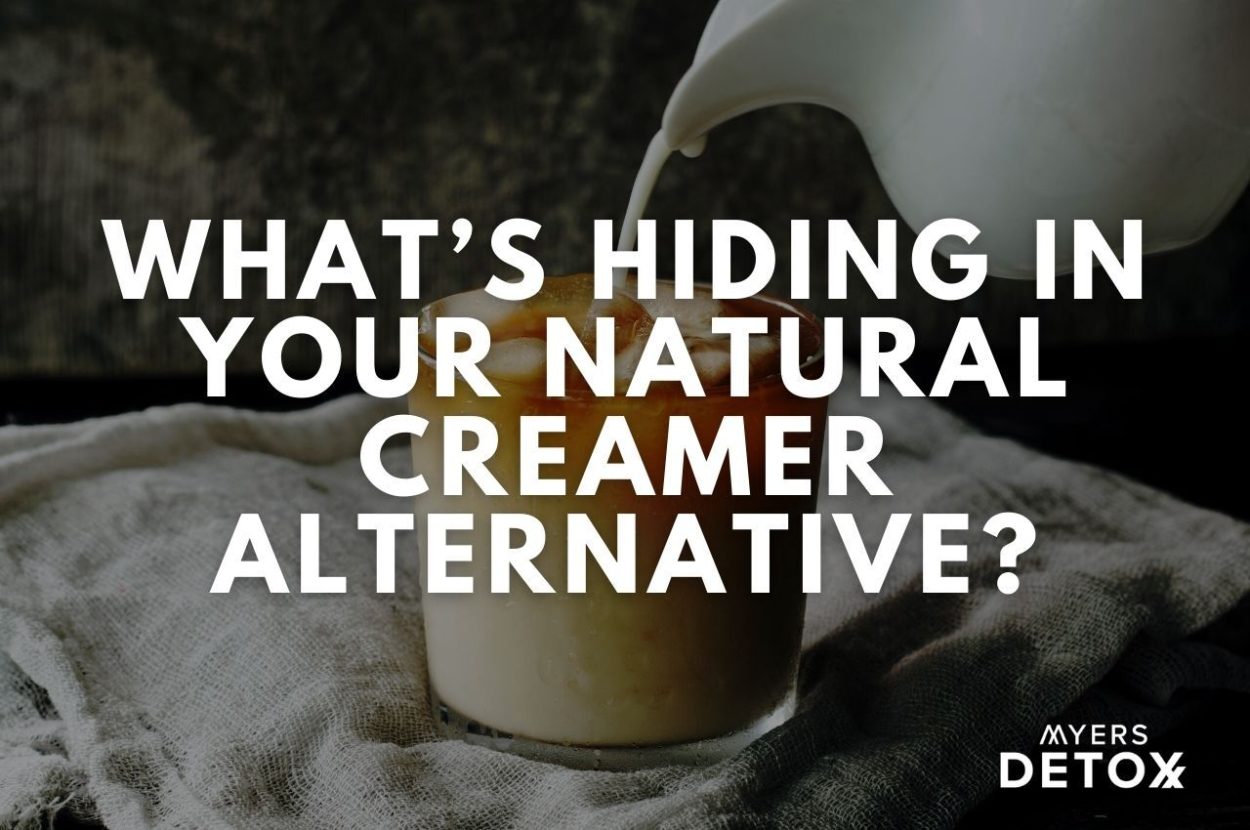Some companies do a great job with their dairy alternatives. You wouldn’t even believe that the milk you’re pouring over your cereal or creamer in your coffee is made from ingredients like almonds, coconuts, and oats. But that smooth taste and mouthfeel often comes with a price.
It takes a little more than magic to turn almonds or coconuts into something resembling actual dairy milk or creamer — and that’s why you need to be on alert when purchasing these dairy-alternative products.
There may be some real health and environmental benefits to switching over to plant-based products, but knowledge is crucial if you’re looking for healthy alternatives.
In this article, you’ll learn:
- Why dairy-free products are becoming so popular
- The dangerous ingredients that manufacturers use in dairy alternatives
- What types of health conditions could be exacerbated by using dairy-free products
The Rising Popularity Of Dairy Alternatives
In the past ten years or so, the traditional refrigerated dairy section at the grocery store has found itself divided. While you still have access to your run-of-the-mill whole milk, heavy whipping cream, and butter, you’ll also find products like almond milk, cashew creamer, and soy cheese.
Where did the popularity of these dairy alternatives come from?
Back in the ’90s, a glass of milk a day was touted as the best way to get your calcium in. You want to grow strong and healthy? Drink milk.
But as health experts began to question the dietary guidelines coming from the government, the ground started to get a little shaky for the dairy industry. While dairy products are indeed a good source of calcium, there are plenty of plant-based calcium sources that can also do the trick (for instance, tofu, green vegetables, and beans)[1].
What’s more, many people have issues digesting dairy and even more want to shift towards a plant-based diet, making opting for dairy-alternatives a no-brainer.
While milk allergies and sensitivities are nothing new, the push towards plant-based products has become a rallying force in the last decade. Whether you can digest dairy or not, you have likely at least tried one of the popular dairy alternatives on the market. In fact, some people even like them more than traditional products.
What many people don’t understand is that there is a crucial difference between plant-based and healthy. If you’ve been switching over to dairy alternatives, you must be aware of some harmful ingredients that are often included in these products.
Ingredients To Watch Out For In Your Milk and Creamer Alternatives
Natural Flavors
The problem with “natural flavors” is that this term is highly unregulated and could truly mean almost anything. The FDA has yet to define what the word “natural” actually means, and therefore manufacturers can pretty much slap it on anything without much repercussion[2].
You can be sure that the original source of a natural flavor must come from a plant or animal, but what part is used, how it’s processed, and the safety are completely up in the air.
Perhaps most concerning is the fact that many natural flavors, colors, and fragrances come from genetically modified sources. And of course, this does not need to be disclosed on the label[3].
When it comes to “natural” flavors, it’s not what we do know but what we don’t know that’s truly the problem.
Carrageenan
If you pick up a dairy alternative with carrageenan as an ingredient, just put it down.
Carrageenan is a food additive that comes from red seaweed that acts as a food thickener, emulsifier, and preservative, making it a very popular ingredient in nut-based milk alternatives.
Although it may bring a lot to the table from a food science standpoint, this particular food additive has some significant drawbacks.
The most concerning research shows that carrageenan can instigate inflammation in your digestive tract and may cause ulcerations[4].
Intestinal inflammation is known to be at the root of many digestive disorders such as IBS, crohn’s disease, and IBD, which makes the ingestion of carrageenan particularly troublesome[5][6].
Other side effects associated with carrageenan include stomach cramps, diarrhea, gas, bloating[7].
Gums
Most of the dairy-alternatives that you’ll find on the shelves include at least one type of gum. The most common are guar gum, xanthan gum, and gellan gum.
Gums are primarily used to thicken, emulsify, or stabilize your milk or cream alternatives.
While some research supports the health benefits of gums, if you have any type of digestive issue (which many people in the United States do), there could be issues with consuming these ingredients. And since dairy alternatives tend to be used on a daily basis, the frequency of use could contribute significantly to digestive discomfort.
Xanthan gum acts as a thickener and stabilizer that can be found in food, personal care, and even industrial products. Although some research shows that it may have benefits like regulating blood sugar, lowering cholesterol, and improving constipation, in large quantities, xanthan may cause loose stools, gas, and diarrhea[8][9][10].
Gellan gum is found in a variety of foods and is primarily used to stabilize ingredients and add a creamy texture. Gellan gum has also been found to reduce blood sugar and cholesterol, but this may come at a price[11].
Animal research has shown that gellan gum causes damage to the microvilli in rats — an important aspect of absorption. Microvilli are tiny finger-like projections that increase your small intestine’s surface area, allowing for more optimally absorption of nutrients. Damage to microvilli could result in a serious impairment of water and nutrient uptake[12].
Guar gum is added to foods primarily as a thickener due to its ability to retain and hold water. It’s also added to cosmetics, medications, and some textiles. Although some research shows that it may act as a prebiotic, it also comes with potential side effects like gas and constipation due to its powerful binding capacity[13][14].
One study found that guar gum even caused small bowel obstruction in large amounts, but it should be noted that this was a far greater amount of guar than you would find in your dairy alternatives[15].
While for many people, these gums may not cause an issue, if you have any digestive conditions like SIBO (Small Intestinal Bacterial Overgrowth), IBS (Irritable Bowel Syndrome), or IBD (Irritable Bowel Disease), you will definitely want to watch your intake.
Sugar
Whole milk comes with natural sugars that give it a subtle sweet flavor. In an effort to emulate the sweetness of real milk, many manufacturers add in extra sugar to balance the flavor and sometimes to cover the taste of proteins like pea protein.
While a little extra sugar isn’t a big deal, many milk and creamer alternatives come with added sugar as their second or third ingredient. Therefore, when looking for a dairy alternative, always check the ingredients list for where the added sugar is, and if possible, go with unsweetened.
Vegetable Oils
Many milk alternatives contain vegetable oils like soybean oil, canola oil, and sunflower oil to add a thicker texture. While this may enhance the mouthfeel of the milk or creamer, vegetable oils are highly processed, and there are some real concerns around sourcing — not to mention the nutritional profile.
Vegetable oils are one of the most common sources of omega-6 fatty acids in the Western diet and can be found in everything from snack foods, frozen meals to that non-dairy creamer you add to your coffee every morning.
Omega-6 fatty acids can be highly inflammatory to your body, and with inflammation being the root cause of many diseases, it’s crucial that you balance out any intake of omega-6’s with anti-inflammatory omega-3s[16].
The problem is, in general, people in the US get way more omega-6 fatty acids than omega-3’s. In fact, the Western diet is estimated to contain a ratio of 15:1 omega-6 to Omega-3, while the optimal ratio is believed to be 1:1[17].
Vegetable oils are also commonly extracted with toxic chemicals like hexane, which can be left behind in the oil that you consume[18]. What’s more, many vegetable oil crops like canola and soy are GMO, adding to these ingredients’ potentially toxic nature[19].
The Takeaway on Natural Creamer Alternatives
Plant-based dairy products are becoming more and more popular each year. You can now find everything from cream cheese to butter to milk and creamer in a plant-based friendly format.
While these products offer vegan and food-sensitivity options for many, the health halo that many people put on them is worth some scrutiny. Just like any other food product that you put in your cart, taking a long and hard look at the ingredients is essential.
This is especially important if you suffer from digestive issues — but no one is safe from the detrimental impact of potentially harmful ingredients in dairy alternatives.
When looking for a milk or creamer substitute, keep an eye out for natural flavors, carrageenan, gums, added sugar, and vegetable oils. As always, your safest bet is to choose a creamer alternative product that contains only a handful of ingredients, all of which you can pronounce.
There are a couple of dairy-alternatives that I personally really love. I don’t do well with cows milk, so I opt for camels milk instead. It comes powdered and you can buy it online. For those that are dairy sensitive and okay with consuming animal milk this is the best option.
I also really love the coconut creamer by Laird Superfood. It’s rich and creamy, and tastes just like a traditional milk creamer — maybe even better.
Of course, you can also opt to make your own natural creamer alternative – that way you know exactly what is going into it (and your body). I personally like this recipe for homemade nut milk! Enjoy!










